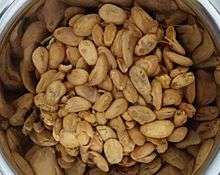Parkia timoriana
| Parkia timoriana | |
|---|---|
 | |
| Scientific classification | |
| Kingdom: | Plantae |
| (unranked): | Angiosperms |
| (unranked): | Eudicots |
| (unranked): | Rosids |
| Order: | Fabales |
| Family: | Fabaceae |
| Genus: | Parkia |
| Species: | P. timoriana |
| Binomial name | |
| Parkia timoriana (DC.) Merr. | |
| Synonyms | |
|
Parkia javanica | |

Parkia timoriana is a species of flowering plant in the legume family. English common names include tree bean.[1][2][3] Common names in other languages and regions include petai hutan in Borneo,[4] yongchak in Manipur, India,[3] nitta tree[5] and riang in Thailand, kedawung and peundung in Java, alai in Sumatra, petai kerayong and batai hutan in Malaysia, and kupang and amarang in the Philippines.[6] It is native to Thailand, Malaysia, Myanmar, Indonesia, and Assam in India. It is widely cultivated for food and wood,[7] and as an ornamental.[8]
The tree is vulnerable to the pest insect Cadra cautella, a moth. The larva bores into the seed to pupate, feeding on the seed interior and filling it with webbing. It also consumes the flower heads.[3]
Description
This plant is a tree growing up to 30 meters tall. The leaf is bipinnate. It is divided into 20 to 30 or more leaflets called pinnae, which are up to 12 centimeters long. Each pinna is divided into 50 to 60 pairs of smaller, narrow leaflets each up to a centimeter long. The inflorescence is a head of flowers dangling at the end of a peduncle up to 45 centimeters long. The flower head is a few centimeters wide and contains several flowers with five-lobed corollas. The fruit is a long, flattened legume pod up to 36 centimeters long which contains up to 21 hard, black seeds each around 2 centimeters long.[9]
The flowers of this tree are pollinated by Old World fruit bats,[10] especially Eonycteris spelaea, which feeds on the nectar. Bats are more efficient pollinators of the flowers than are the insects that also visit.[11]
Uses
There are a number of human uses for this tree. The wood is used for firewood and lumber.[1] In Africa the wood is not generally used, but the tree is often planted for ornamental purposes.[8] It is a popular garden tree in India,[3] particularly in Assam, where it is a "characteristic feature" of Meitei backyards.[12] It is tolerant of sun and shade.[13]
Products of the tree are well known in many areas as foods. The long pod is eaten as a vegetable. It can be added to salad and chutney.[1] In Thai cuisine this vegetable is known as nitta sprout, and it is added to curry.[14] The hard, black seeds are eaten fresh, or they can be dried and stored.[1] The seeds have a strong sulphur smell, which is due to the presence of thioproline.[1] Some find this smell and similar taste so appealing that they consider the seeds a delicacy.[15] In some areas, the seeds of the related tree species Parkia speciosa are much more popular, and tree bean will be consumed as a second choice.[4]
See also
References
- 1 2 3 4 5 Thangjam, R. and L. Sahoo. (2012). In vitro regeneration and Agrobacterium tumefaciens-mediated genetic transformation of Parkia timoriana (DC.) Merr.: A multipurpose tree legume. Acta Physiol Plant 34 1207-15.
- ↑ Luttge, U., et al., Eds. Progress in Botany, Volume 74. Springer. 2013. pg. 85.
- 1 2 3 4 Thangjam, R., et al. (2003). Cadra cautella Walker (Lepidoptera: Crambidae:Phycitinae) – A pest on Parkia timoriana (DC.) Merr. in Manipur. Current Science 85(6) 725-26.
- 1 2 Schulte, A. and D. H. Schöne, Eds. Dipterocarp Forest Ecosystems: Towards Sustainable Management. World Scientific. 1996. pg. 80.
- ↑ Flora. Khao Phra Thaew Ecological Sustainability Project. Wild Animal Rescue Foundation of Thailand. 2009.
- ↑ CABI. Parkia timoriana. In: Forestry Compendium. CAB International. Wallingford, UK. 2013.
- ↑ Parkia timoriana. Germplasm Resources Information Network.
- 1 2 Louppe, D., et al. Timbers. PROTA. 2008. pg. 417.
- ↑ Parkia timoriana. Flora of China.
- ↑ Fleming, T. H., et al. (2009). The evolution of bat pollination: a phylogenetic perspective. Annals of Botany 104(6) 1017–1043.
- ↑ Bumrungsri, S., et al. (2008). The pollination ecology of two species of Parkia (Mimosaceae) in southern Thailand. Journal of Tropical Ecology 24(5) 467-475.
- ↑ Devi, N. L. and A. K. Das. (2010). Plant species diversity in the traditional homegardens of Meitei community: A case study from Barak Valley, Assam. Journal of Tropical Agriculture 48(1-2) 45-8.
- ↑ DENR, other govt employees start planting trees in compliance with National Greening Program. Talk.com.ph. July 13, 2011.
- ↑ Tangkanakul, P., et al. (2011). Antioxidant capacity and antimutagenicity of thermal processed Thai foods. JARQ 45(2) 211-18.
- ↑ Thangjam, R. and D. D. Maibam. (2012). Sulphur free radical reactivity of thioproline and crude extracts of Parkia timoriana (DC.) Merr. Environmental Engineering Research 17(S1) S9-S13.
External links
 Media related to Parkia timoriana at Wikimedia Commons
Media related to Parkia timoriana at Wikimedia Commons